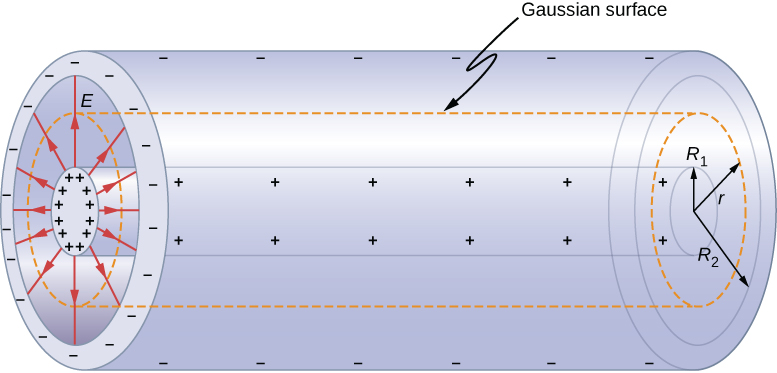| << Chapter < Page | Chapter >> Page > |
Check Your Understanding The radius of the outer sphere of a spherical capacitor is five times the radius of its inner shell. What are the dimensions of this capacitor if its capacitance is 5.00 pF?
3.59 cm, 17.98 cm
A cylindrical capacitor consists of two concentric, conducting cylinders ( [link] ). The inner cylinder, of radius , may either be a shell or be completely solid. The outer cylinder is a shell of inner radius . We assume that the length of each cylinder is l and that the excess charges and reside on the inner and outer cylinders, respectively.

With edge effects ignored, the electrical field between the conductors is directed radially outward from the common axis of the cylinders. Using the Gaussian surface shown in [link] , we have
Therefore, the electrical field between the cylinders is
Here is the unit radial vector along the radius of the cylinder. We can substitute into [link] and find the potential difference between the cylinders:
Thus, the capacitance of a cylindrical capacitor is
As in other cases, this capacitance depends only on the geometry of the conductor arrangement. An important application of [link] is the determination of the capacitance per unit length of a coaxial cable , which is commonly used to transmit time-varying electrical signals. A coaxial cable consists of two concentric, cylindrical conductors separated by an insulating material. (Here, we assume a vacuum between the conductors, but the physics is qualitatively almost the same when the space between the conductors is filled by a dielectric.) This configuration shields the electrical signal propagating down the inner conductor from stray electrical fields external to the cable. Current flows in opposite directions in the inner and the outer conductors, with the outer conductor usually grounded. Now, from [link] , the capacitance per unit length of the coaxial cable is given by
In practical applications, it is important to select specific values of C / l . This can be accomplished with appropriate choices of radii of the conductors and of the insulating material between them.
Check Your Understanding When a cylindrical capacitor is given a charge of 0.500 nC, a potential difference of 20.0 V is measured between the cylinders. (a) What is the capacitance of this system? (b) If the cylinders are 1.0 m long, what is the ratio of their radii?
a. 25.0 pF; b. 9.2
Several types of practical capacitors are shown in [link] . Common capacitors are often made of two small pieces of metal foil separated by two small pieces of insulation (see [link] (b)). The metal foil and insulation are encased in a protective coating, and two metal leads are used for connecting the foils to an external circuit. Some common insulating materials are mica, ceramic, paper, and Teflon™ non-stick coating.

Notification Switch
Would you like to follow the 'University physics volume 2' conversation and receive update notifications?